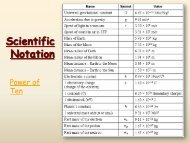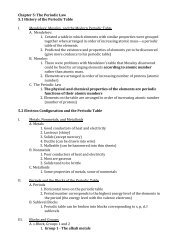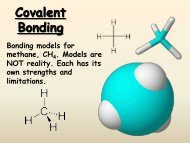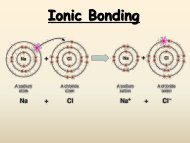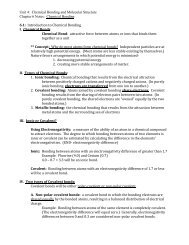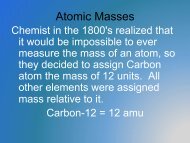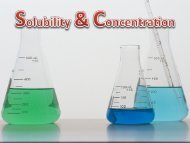Solutions & Solubility
Solutions & Solubility
Solutions & Solubility
Create successful ePaper yourself
Turn your PDF publications into a flip-book with our unique Google optimized e-Paper software.
Chapter 12.1 & 12.23221.2.2 Identify the solute and solvent compositionof a solid, liquid or gaseous solution.3221.2.5 Factors that affect the rate of solution3221.2.8 Use a solubility graph, composition of asolution and temperature to determine if a solution issaturated, unsaturated, or supersaturated.
Classification of MatterMatterPureSubstancesMixturesHeterogeneousHomogeneousElementsCompounds
Types of MixturesHeterogeneous mixtures: nota definite or uniformcompositionExample: soil, concrete, blood
Types of MixturesHeterogeneousHomogeneousEven though weSkim have Milkhomogenizedmilk, if you look atit very closely, youcan Whole see that Milk the fatglobules, and thewhey are notevenly distributedat the Cream molecularlevel.Where doesit belong?MilkIt depends on howclosely you look at it.
Types of MixturesHomogeneous mixtures:Uniform appearanceExample: saltwater
A solution is ahomogeneous mixture oftwo or more substances ina single phase.
Components of <strong>Solutions</strong>Solvent (does the dissolving)Dissolving medium in a solution:Solute (dissolved)Substance dissolved in a solution:There can be one or more solutes.The solvent is always the one with themost volume.
Saltwater:Sodium and chlorine areinterspersed among thewater molecules.(Dissolved)
Saltwater:Salt- pure substanceWater- pure substanceboth have definite compositionSaltwater- mixture- uniform, butnot a definite composition.
Dissolving of Salt in water
<strong>Solubility</strong>If you add spoonful after spoonful of sugar to tea,eventually no more sugar will dissolve.There is a limit to the amount of solid that canbe dissolved.The point at which this limit is reached for anysolute-solvent combination depends on the nature ofthe solute, the nature of the solvent, and thetemperature.
<strong>Solubility</strong>When a solute is first added to a solvent, solute moleculesleave the solid surface and move about at random in thesolvent.As more solute is added, more collisions occur betweendissolved solute particles. Some of the solute moleculesreturn to the crystal.When maximum solubility is reached, molecules arereturning to the solid form at the same rate at which theyare going into solution.click
Unsaturated solutions containless than the maximum amountof solute possible.As more solid is added to thissolution, it will dissolve.
Saturated solutions containall the solute that is possibleto dissolve under a given setof conditions.As more solid is added to thissolution, it will not dissolve.
Supersaturated solutions areunstable solutions that havebeen forced to dissolve moresolute than should be possibleunder a given set of condition.click
<strong>Solubility</strong><strong>Solubility</strong> varies greatly with thetype of compounds involved.Like dissolves like is a roughbut useful rule for predictingwhether one substance willdissolve in another.clickhere
The slightly charged parts ofwater molecules (polar) attractthe ions in the ionic compoundsand surround them, separatingthem from the crystal surfaceand drawing them into thesolution.
Nonpolar SolventsIonic compounds aregenerally not soluble innonpolar solvents such ascarbon tetrachloride, CCl 4 ,and toluene, C 6 H 5 CH 3 .
Click here
FYI:
Oil and water do not mix because oilis nonpolar whereas water is polar.Two polar substances, or twononpolar substances, on theother hand, form solutionstogether easily because theirintermolecular forces match.Like dissolves like
Effects of Pressure on <strong>Solubility</strong>Changes in pressure have very littleeffect on the solubilities of liquids orsolids in liquid solvents.However, increases in pressureincrease gas solubilities inliquids.The rapid escape of a gasfrom a liquid in which it isdissolved is known aseffervescence.Click here
Effects of Temperature on<strong>Solubility</strong>Increasing the temperature usuallydecreases gas solubility.Increasing the temperature usuallyincreases solubility of solids inliquids.
Factors Affecting <strong>Solubility</strong>1. Nature of Solute / Solvent. - Like dissolves like2. Temperature -i) Solids/Liquids- <strong>Solubility</strong> increases with TemperatureIncrease K.E. increases motion and collision betweensolute & solvent.ii) gas - <strong>Solubility</strong> decreases with TemperatureIncrease K.E. result in gas escaping to atmosphere.3. Pressure -i) Solids/Liquids – does not affect solid or liquid solutesSolids and Liquids are already close together, extra pressurewill not increase solubility.ii) gas - <strong>Solubility</strong> increases with Pressure.Increase pressure squeezes gas solute into solvent.
Factors Affecting the Rateof Dissolutionü Surface area of thesolute is increased.ü Stirring or shakingü Higher temperatures
Factors Affecting the Rateof DissolutionClick image above
<strong>Solubility</strong> ValuesclickThe solubility of a substance is the amountof that substance required to form asaturated solution with a specific amount ofsolvent at a specified temperature.• example: The solubility of sugar is 204 g per 100 g of water at20°C.• Solubilities vary widely, and must bedetermined experimentally.• They can be found in chemical handbooks and are usually given asgrams of solute per 100 g of solvent at a given temperature.
Solubilities of severalionic solids as a functionof temperature. MOSTsalts have greatersolubility highertemperature.Gases have negativeheat of solution,(exothermic process)and they become lesssoluble with increasingtemperature.
Problems:How many grams ofNaNO 3 are required tomake a saturated solutionin 100 g H 2 O at 30 °C?Start at 30 °C, moveup to the NaNO 3 line.Move across to solute(g). 96 grams can bedissolved in 100 gH 2 O at 30 °C.
What is the solubility ofKCl in 400. g of H 2 O at50 °C?Find value for 100 gH 2 O. (42 g)42 g_ = x_100 g 400 g= 168 KCl
What kind of solution doyou have if 80 g KClO 3are dissolved in 100 gH 2 O at 70 °C?Start at 80 gramsand 40 °C. Seewhere the linesintersect withrespect to theKClO 3 line. Theyintersect far abovethe KClO 3 line.This solution issupersaturated.





